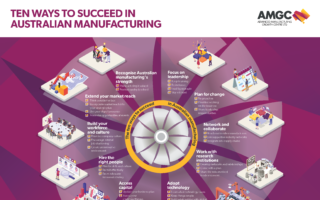Moving from a lucky country to a smart country: Ten Ways for Australian manufacturers to Succeed
The latest industry research report from the Federal Government’s Advanced Manufacturing Growth Centre (AMGC) has revealed that even before the COVID-19 pandemic, 65% of Australians regarded manufacturing as important or very important. Yet, key challenges are holding back the industry from growth opportunities.
Titled “Ten Ways to Succeed in Australian manufacturing”, AMGC’s report identifies the manufacturing industry’s pain points and opportunities as a result of expansive industry consultation. These points were stress-tested against industry peers, the public and over 1,000 students to gauge where Australian manufacturers can focus to better align their practices, to increase positive perception, and to grow their overall business impact.
COVID-19 then struck, thrusting Australian manufacturing into the national spotlight. Manufacturers responded in record time to produce everything from hand sanitiser to invasive ventilators. However, for some, the impact of the pandemic served to reinforce pain points identified in the report and that businesses need to be worked ‘on’, rather than ‘in’.
The response to the pandemic has proven that there is a high level of onshore manufacturing capability and significant public appreciation for the industry. By adopting ten practical steps, manufacturers can become smarter operators: more advanced, resilient, competitive, and globally impactful.
“Australia remains very much a manufacturing nation, reliant on global trade. We must take decisive action to reduce our dependence on the export of primary raw materials and transition from being a lucky country to a smart country, by adding value and advancing our onshore capabilities,” said Dr Jens Goennemann, Managing Director of the Advanced Manufacturing Growth Centre.
“We must expand our understanding and look beyond the outdated view that manufacturing is just production. Manufacturing is a capability, an enabler and a vital component of our economy, it is a key driver of prosperity – it deserves our attention and needs to be nurtured,” said Dr Goennemann.
Paul Cooper, Chairman at the Advanced Manufacturing Growth Centre, said AMGC’s latest report arrives at a very important time for the manufacturing industry.
“By embracing technology, attracting the right people, investing for growth and actively managing their business, Australian manufacturers can realise substantial benefits for their business and in the process support greater local jobs and capabilities,” said Mr Cooper.
“Ten Ways to Succeed in Australian manufacturing” offers the following insights:
1. Australia needs to recognise its manufacturing strength:
- 60% of Australians believe manufacturing is changing, becoming safer and more innovative
- Youth see potential in manufacturing careers, rate job security and career progression highly
- Industry and media have an active role to play in addressing common industry myths (page 12)
2. Manufacturers should focus on good leadership:
- Local management skills rate average when compared to countries with similar GDP (page 15)
- Good leadership is crucial to success and practical steps can be taken to address leadership issues
- Business culture, self-confidence and leading by example are vital for innovation and growth
3. Change has to be planned for:
- 88.2% of business do not have a strategic plan, while 42% do not monitor KPIs (page 19)
- AMGC found business owners and operators worked ‘in’ rather than ‘on’ the business
- Manufacturers are encouraged to make time to plan, seek advice and engage with industry or governmental support agencies to unlock potential
4. Build a network and collaborate:
- The 12% of Australian manufacturers that collaborate are more successful
- ‘Zero-sum’ thinking is a barrier to growth. Collaborating with peers and research institutions can unlock productivity, quality and product gains while delivering 8% in revenue gains (page 25).
- Australian manufacturers’ competitors are not the businesses next door, but the businesses overseas
5. Work with Australian research institutions:
- 81% of small- and 75% of medium-sized enterprise do not engage with research institutions
- Manufacturers that invested in collaboration are more successful than those that do not
- It is a two-way street: Researchers gain practical experience, industry gains expert insight (page 32)
6. Adopt technology
- Far from being a ‘job-killer’, technology is an enabler and equaliser, it can lead to productivity, quality and upskilling opportunities
- Australian manufacturers lag other industries in adopting advanced technologies (page 36)
- Some manufacturers are ‘put-off’ by a lack of understanding or misconceptions about the cost of investment, these businesses should seek expert advice (page 37)
7. Accessing capital
- One in five Australian businesses have stated difficulty accessing finance and 45% of SMEs do not use accountancy software
- 17.6% of respondents cited access to capital as an obstacle. 15.8% also cited cost inputs as a barrier and 18.6% listed overdue accounts as a handbrake on capital (page 43)
- Accessing capital should not be onerous. Having an up-to-date business plan (Way 3), accessing grants and talking to your financial institution are good places to start
8. Hire the right people
- Manufacturing suffers from one of the highest skills shortages at 17% (page 49)
- Just 3% of students considered a career in manufacturing, and many were advised to seek careers elsewhere
- Two-thirds of the public recognise that manufacturing is evolving and will become more innovative
- Talent can be sourced by engaging with local schools, providing internships, and using technology to recruit
9. Build your workforce culture
- Building a healthy workplace culture can lead to a ready talent pool and an engaged workforce
- In-house upskilling, job shadowing and mentoring lead to better performing and more productive teams
- Culture is not a nice to have, it is a must-have and can impact retention and innovation
10. Extend your market reach
- Just 5% of Australian manufacturers account for 99% of the industries’ total export value (page 68)
- 80% of Australians recognise that trade and export of Australian goods benefit the economy
- Companies that export demonstrate growth, productivity, profitability and wage benefits and more should take active steps to increase their reach and customers
A complete copy of the report can be downloaded here.
Broadcast quality B-Roll video of Australian manufacturing in action can be downloaded from here


